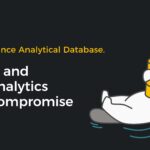Introduction to Polars: Why You Should Make the Switch
In the world of data science and analysis, Pandas has long been the go-to library for handling data. However, as the size of datasets continues to grow, Polars has emerged as a faster, more efficient alternative. Polars is designed to optimize data processing speed, particularly when working with large datasets. Built from the ground up with multi-threading and lazy execution, Polars can process large volumes of data with less memory consumption, outperforming Pandas in various scenarios.
In this article, we will explore the advantages of Polars, compare it with Pandas, and show you how to effectively filter data from CSV and Excel files using Polars.
Polars vs. Pandas: A Comparison
While Pandas has been the standard tool for data manipulation, Polars offers significant improvements, especially for large datasets:
1. Performance
- Polars is optimized for speed. It leverages multi-threading to process data across multiple CPU cores, which makes it much faster than Pandas when handling large datasets.
- Pandas, by default, uses a single thread, and its performance can degrade when dealing with massive amounts of data.
2. Memory Efficiency
- Polars uses an optimized columnar storage format, which reduces memory consumption when working with big data. It processes data more efficiently, without requiring large amounts of RAM.
- Pandas, on the other hand, loads the entire dataset into memory, which can lead to performance issues or even crashes with very large datasets.
3. Lazy Execution
- Polars supports lazy evaluation, meaning it can delay the computation of operations until the result is actually needed. This allows Polars to optimize the entire workflow and minimize unnecessary computations.
- Pandas executes operations immediately (eager execution), which can lead to redundant calculations, especially in complex pipelines.
4. API Compatibility
- While Pandas has a more mature and feature-rich API, Polars offers a similar, easy-to-use API with a growing set of features. For many common tasks, Polars can serve as a drop-in replacement for Pandas, especially for data filtering and transformation.
5. Scalability
- Polars scales much better for big data. When dealing with millions or billions of rows, Polars can handle the load much more efficiently, thanks to its design choices.
- Pandas can slow down significantly with larger datasets, and memory management becomes a concern.
Why Choose Polars Over Pandas?
If you’re working with large-scale datasets and need a fast, efficient solution that doesn’t compromise on performance or memory usage, Polars is the clear winner. Its ability to process data faster and with less memory makes it the ideal choice for data engineers, analysts, and scientists who deal with massive data files regularly.
Moreover, Polars‘ API is easy to learn, especially for users familiar with Pandas. It supports a wide range of operations, including data filtering, aggregation, and transformation, all while keeping memory consumption low.
How to Filter Data from CSV/Excel Files Using Polars
Now, let’s dive into how to filter data from CSV and Excel files using Polars. We’ll walk through an example for both file formats, so you can see how easy it is to get started with Polars.
1. Install Polars
First, you’ll need to install the Polars library. You can do this using pip:
pip install polars2. Filtering Data from a CSV File
Let’s assume we have a CSV file named data.csv with the following content:
| Name | Age | Department |
|---|---|---|
| Alice | 25 | HR |
| Bob | 30 | IT |
| Charlie | 35 | HR |
| David | 40 | IT |
We want to filter out all employees who are older than 30.
Code to Read and Filter CSV:
import polars as pl
# Read the CSV file into a Polars DataFrame
df = pl.read_csv("data.csv")
# Filter the DataFrame to get only rows where Age > 30
filtered_df = df.filter(pl.col("Age") > 30)
# Show the filtered result
print(filtered_df)Output:
shape: (2, 3)
┌─────────┬─────┬────────────┐
│ Name │ Age │ Department │
│ --- │ --- │ --- │
│ str │ i64 │ str │
├─────────┼─────┼────────────┤
│ Charlie │ 35 │ HR │
│ David │ 40 │ IT │
└─────────┴─────┴────────────┘3. Filtering Data from an Excel File
Polars does not yet have built-in support for reading Excel files directly. However, you can use pandas to load the Excel file and then convert it to a Polars DataFrame. Here’s how to do it:
Code to Read and Filter Excel:
import pandas as pd
import polars as pl
# Read the Excel file into a pandas DataFrame
df_pandas = pd.read_excel("data.xlsx")
# Convert the pandas DataFrame to a Polars DataFrame
df_polars = pl.from_pandas(df_pandas)
# Filter the DataFrame to get only rows where Age > 30
filtered_df = df_polars.filter(pl.col("Age") > 30)
# Show the filtered result
print(filtered_df)Output:
shape: (2, 3)
┌─────────┬─────┬────────────┐
│ Name │ Age │ Department │
│ --- │ --- │ --- │
│ str │ i64 │ str │
├─────────┼─────┼────────────┤
│ Charlie │ 35 │ HR │
│ David │ 40 │ IT │
└─────────┴─────┴────────────┘Conclusion: Why You Should Start Using Polars
Polars is a powerful tool for data processing, offering faster speeds, lower memory usage, and greater scalability compared to Pandas, especially for large datasets. It’s easy to learn and provides an API that will feel familiar to Pandas users.
By switching to Polars, you can handle larger datasets more efficiently without compromising on performance. Whether you’re working with CSV or Excel files, Polars offers a streamlined experience for filtering, transforming, and analyzing your data.
For anyone working with big data or seeking faster data processing, Polars is definitely worth considering as your go-to data manipulation tool. Try it out today and see how it outperforms Pandas in your data analysis tasks!
Get Started with Polars Today!
Ready to boost your data processing performance? Install Polars now and start filtering data like a pro! Whether it’s a CSV file or Excel data, Polars helps you work faster, smarter, and more efficiently.







Leave a Reply